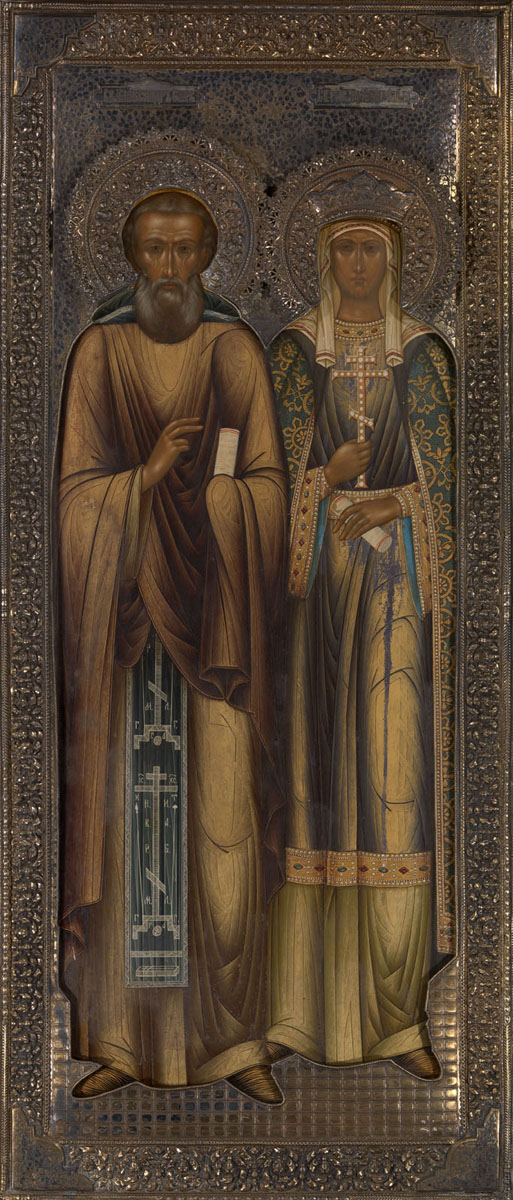MacDougall Auctions 2-3 December 2009
2 December 2009

* 25. THE VENERABLE ALEXANDER SVIRSKY AND PRINCESS OLGA IN SILVER OKLAD
MOSCOW, DIKAREV'S WORKSHOP, OKLAD ST PETERSBURG, 1882
101.5 by 47.5 cm.
80,000-120,000 pounds
This item is an extremely rare example of a large church icon, the iconography, composition, style, and particular details of which all point to the workshop of Mikhail Ivanovich Dikarev, a famous icon-painter from Mstera (Vladimir region), as the place of its origin. In the 1870s Dikarev moved from his native village to Moscow, where he started his own studio in about 1880, employing many fine Mstera icon-painters. His icons were painted to commission only, usually for patrons of high standing, and consequently Dikarev was appointed as the official iconographer for the court of Great Duke Sergei Alexandrovich Romanov, the governor-general of Moscow and brother to the Emperor Alexander III. In the 1890s the two most famous icon-pain ting studios working in the Mstera style, those of M.I. Dikarev and I.S. Chirikov, executed a vast commission for the Grand Duke Konstantin Konstantinovich, consisting of a complex of 350 small-sized icons for the family chapel of the Marble Palace in St Petersburg. In the same years, Dikarev painted several commissioned icons for private devotion, depicting heavenly patrons of the royal family.
The idea of the ceremonial image of the Venerable Alexander of Svirsk and Princess Olga is presumably related to the royal family and must be dated to the early period of Dika rev’s Moscow studio activity, or that of the artist himself. The stamp on the oklad suggests that it was made in 1882, when Alexander III’s youngest daughter Olga was born, thus becoming porphyrogenita, that is, born after her father had already ascended the throne. The Princess Olga represented on the icon was one of the rulers who introduced Christianity to Russia and established the Russian state. She was traditionally regarded as a patron saint of royal-born Russian Tsarinas and Princesses; therefore, such a solemn image of her must have resulted from a special commission, intended for one of the churches in St Petersburg. This suggestion is supported by a hallmark of a St Petersburgian assayer, whereas the icon itself is painted by Moscow masters. The accompanying image of St Alexander Svirsky, the namesake of Alexander III (the Imperial patron saint was St Alexander Nevsky) must have testified to the special royal patronage of the Alexander-Svirsky monastery near St Petersburg. It is very possible that the royal couple, expecting the birth of heirs, relied on the saint’s prayers.
The stylistic features of the icon, such as the delicate and intricate Mstera style of painting, the soft modelling of the faces, the fine web of golden assists, the characteristic rendering of “pearls” and “gems” of the vestments, the shading of the folds, and the elaborate ornamentation of the brocade cloaks all closely correspond to the touches and techniques of the works signed by Dikarev himself. The icon is particularly important because only very few large church icons from this famous Moscow studio survived. The artistic features of the heavy silver oklad follow the “Russian style”, very characteristic of the times of Alexander III. They carefully reproduce the embossed “herbage” pattern as well as the ornaments typical
of the 18th-century royal silversmiths.
Notes on symbols:
* Indicates 5% Import Duty Charge applies.
Ω Indicates 20% Import Duty Charge applies.
§ Indicates Artist's Resale Right applies.
† Indicates Standard VAT scheme applies, and the rate of 20% VAT will be charged on both hammer price and premium.